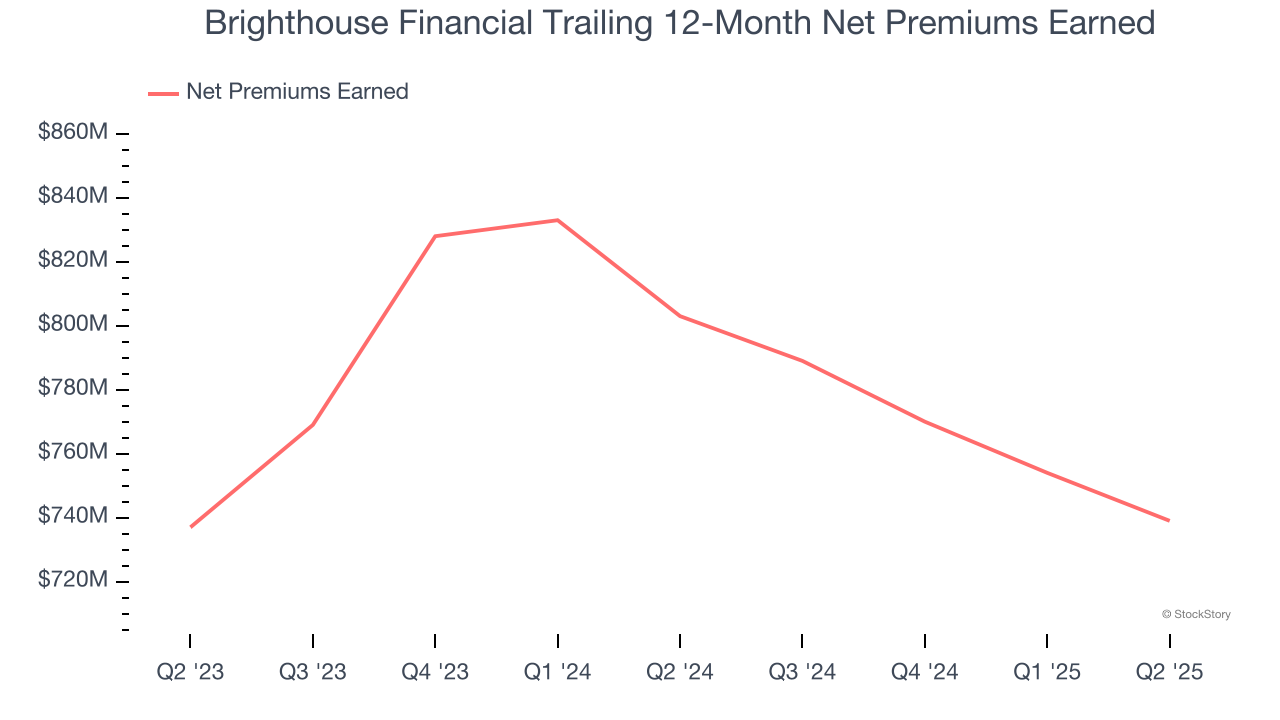
Over the past six months, Brighthouse Financial’s shares (currently trading at $46.93) have posted a disappointing 17.6% loss, well below the S&P 500’s 16.4% gain. This was partly driven by its softer quarterly results and might have investors contemplating their next move.
Is now the time to buy Brighthouse Financial, or should you be careful about including it in your portfolio? Check out our in-depth research report to see what our analysts have to say, it’s free.
Why Is Brighthouse Financial Not Exciting?
Even though the stock has become cheaper, we don't have much confidence in Brighthouse Financial. Here are three reasons there are better opportunities than BHF and a stock we'd rather own.
1. Declining Net Premiums Earned Reflect Weakness
When insurers sell policies, they protect themselves from extremely large losses or an outsized accumulation of losses with reinsurance (insurance for insurance companies). Net premiums earned are therefore net of what’s ceded to reinsurers as a risk mitigation and transfer strategy.
Brighthouse Financial’s net premiums earned has declined by 1.9% annually over the last five years, much worse than the broader insurance industry. This shows that policy underwriting underperformed its other business lines.

2. Steady Increase in BVPS Highlights Solid Asset Growth
In the insurance industry, book value per share (BVPS) provides a clear picture of shareholder value, as it represents the total equity backing a company’s insurance operations and growth initiatives.
Although Brighthouse Financial’s BVPS declined at a 15.1% annual clip over the last five years. the good news is that its growth inflected positive over the past two years as BVPS grew at a solid 15.5% annual clip (from $74.40 to $99.31 per share).

The debt-to-equity ratio is a widely used measure to assess a company's balance sheet health. A higher ratio means that a business aggressively financed its growth with debt. This can result in higher earnings (if the borrowed funds are invested profitably) but also increases risk.
If debt levels are too high, there could be difficulties in meeting obligations, especially during economic downturns or periods of rising interest rates if the debt has variable-rate payments.

Brighthouse Financial currently has $7.15 billion of debt and $5.67 billion of shareholder's equity on its balance sheet, and over the past four quarters, has averaged a debt-to-equity ratio of 1.3×. We think this is dangerous - for an insurance business, anything above 1.0× raises red flags.
Final Judgment
Brighthouse Financial isn’t a terrible business, but it doesn’t pass our quality test. Following the recent decline, the stock trades at 0.6× forward P/B (or $46.93 per share). While this valuation is optically cheap, the potential downside is big given its shaky fundamentals. We're pretty confident there are more exciting stocks to buy at the moment. Let us point you toward the most entrenched endpoint security platform on the market.
Stocks We Like More Than Brighthouse Financial
Trump’s April 2025 tariff bombshell triggered a massive market selloff, but stocks have since staged an impressive recovery, leaving those who panic sold on the sidelines.
Take advantage of the rebound by checking out our Top 9 Market-Beating Stocks. This is a curated list of our High Quality stocks that have generated a market-beating return of 183% over the last five years (as of March 31st 2025).
Stocks that made our list in 2020 include now familiar names such as Nvidia (+1,545% between March 2020 and March 2025) as well as under-the-radar businesses like the once-micro-cap company Tecnoglass (+1,754% five-year return). Find your next big winner with StockStory today.
StockStory is growing and hiring equity analyst and marketing roles. Are you a 0 to 1 builder passionate about the markets and AI? See the open roles here.






